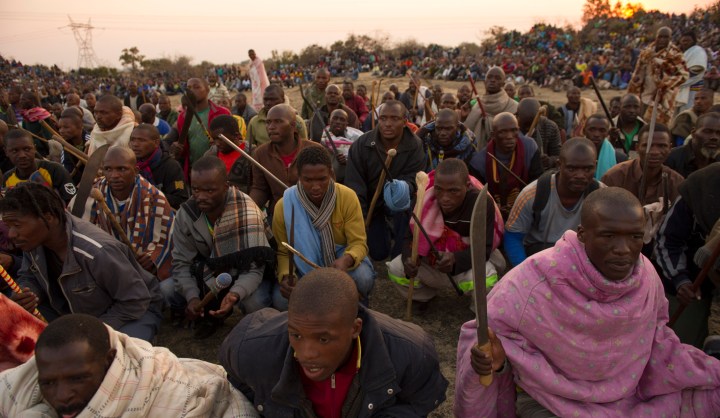South Africa
Marikana Commission: Better videos of 16 August – but still not much to see

On Wednesday, the commission of inquiry into the events of the Marikana labour unrest saw more police footage of what happened on 16 August when the police shot 112 people. This new evidence does not provide a holistic view of what happened, but it will be crucial in building an accurate timeline and placing cops who were involved at various times during that day. By SIPHO HLONGWANE.
Video footage shot from 9 to 16 August at Marikana continued to be shown on Wednesday. The photos and film seen on this day showed the unsuccessful mediation attempts of Association of Mineworkers and Construction Union (AMCU) president Joseph Mathunjwa, shortly before the police operation began. The extreme and hostile attitude of the striking miners is also displayed in stark detail – as is the tail-end of the operation, in one cellphone video that shows police moving through the area known as small koppie, where most of the miners were killed.
The commission also heard a recording of radio traffic from a helicopter that may have directed the operation.
We already know from numerous statements, interviews and recordings that AMCU tried to negotiate with the miners in the lead-up to the massacre.
In one police video, Mathunjwa is heard trying to explain the predicament of being tasked with talking to Lonmin management as a minority and barely-recognised union. The company would apparently not give audience to AMCU without the presence of the “big union”: the National Union of Mineworkers (NUM).
After an impassioned speech by Mathunjwa (upon whom it had dawned that things would likely end up in tragedy), one of the strike leaders then grabbed the megaphone, and demanded that the police should leave. “We are not leaving this place unless we get what we want,” the man said, before making threats to the police (to the effect that those who had come to the hill would not be able to get back in their armoured trucks).
Another video, shot on 9 August, shows the same workers striking without traditional weapons. According to them, they armed after being shot at by NUM security guards a few days before the 16th, and refused to surrender their weapons because they needed them for self-defence. While initial rage was not directed at the police, their increased involvement and attempts to control the men (one initial effort when a small contingent of the wildcat strike was isolated and confronted resulted in the death of two police officers and three miners) changed that.
A very important piece of evidence is a 40-minute recording of radio traffic from one helicopter which carried a Colonel Vermaak and the provincial commissioner for North West, Major General William Mpembe.
The colonel is heard giving instructions to police conducting the operation, including the ominous command not to shoot “while they are running unless they are targeting you” – why would he need to say this?
Later, Vermaak says to police at small koppie: “Get out of the Nyalas. As a protection measure, get out and engage.”
The videos were shown after evidence leaders said that a presentation shown by the police at the commission left them out. They also pointed out that some of the footage suggested that miners were shot at while in a state of panic, due to the onslaught of water cannons and tear gas.
“According to evidence leader Matthew Chaskalson, other available video footage shows that shooting began a mere 30 seconds after the firing of the last tear gas canister and immediately after a water cannon was sprayed, suggesting that miners were shot at while in a state of panic,” the Mail & Guardian reported.
A cellphone video shot by a member of the tactical response team unit showed a small snippet of what happened at small koppie. Officers are seen crouching behind the small boulders in the area, shouting at an unknown person to cease fire. At this stage some of the miners had already been shot, and their bodies are seen next to a collection of traditional weapons.
This footage, while helping to fill in some of the gaps, does not help to form a complete picture even when seen with other videos. The commission has yet to see video footage of the actual shootings.
Earlier, a forensic expert who shot the scene from the air in another helicopter was asked why his video did not zoom in on the koppies where the killings happened. He said that he wasn’t actually aware that things had gone so badly wrong. It’s odd, given that Vermaak’s helicopter circling nearby appears to be directing operations. Were the two helicopters not in communication during the period?
The commission continues on Thursday. DM
Photo: Marikana miners, 15 August 2012. (Greg Marinovich)


















 Become an Insider
Become an Insider